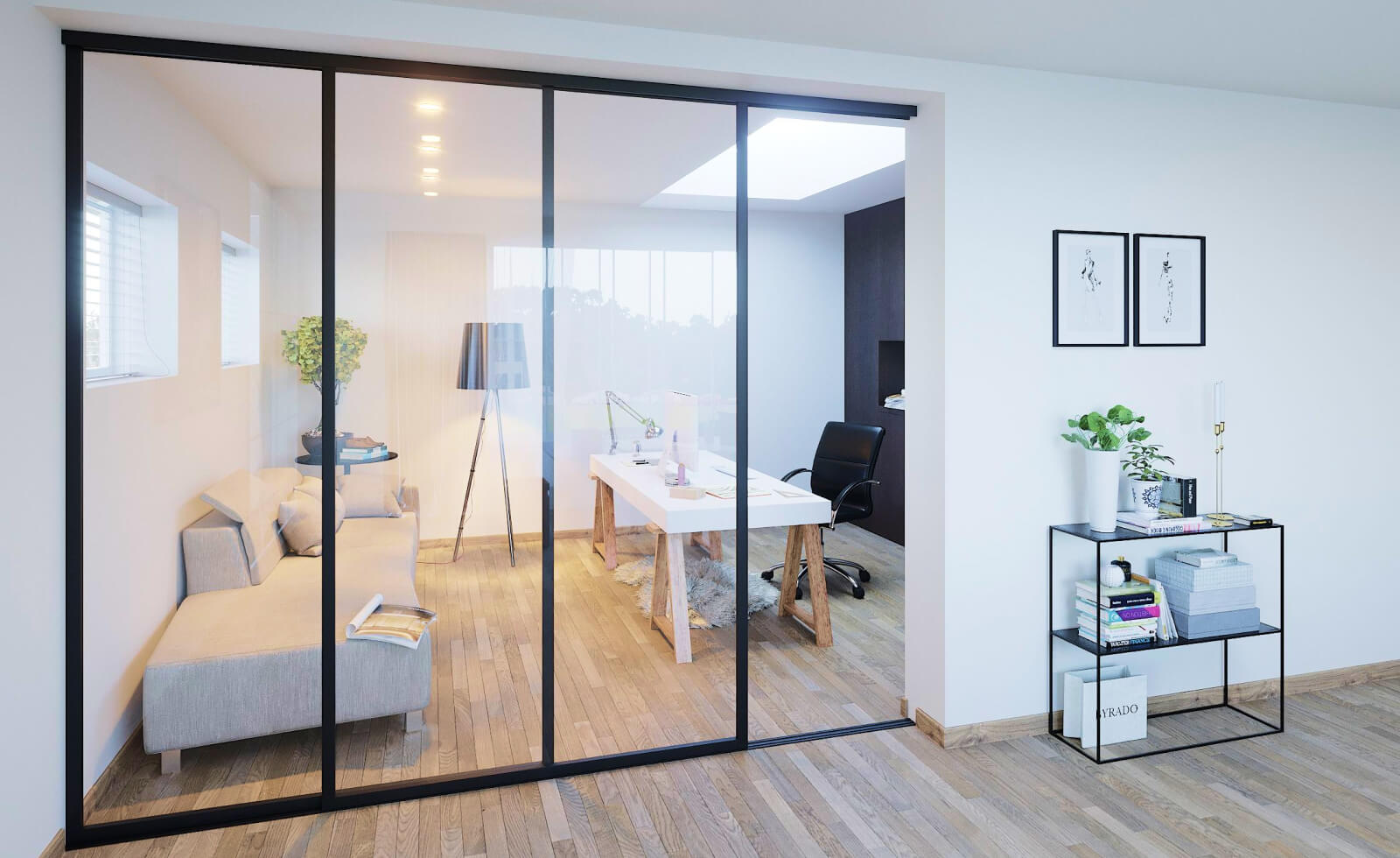
Glass partitions have emerged as a signature element in high-end residential design, offering a refined alternative to conventional walls. They act as architectural instruments that reshape how space is experienced, blurring the line between separation and connection, while transforming natural light into a design feature.
From open-plan living rooms, and kitchens to private home offices, bathrooms, and bedrooms, residential glass partitions introduce flexibility without compromising on structure or visual harmony. This guide provides practical insights into their benefits, key types, installation considerations, and associated costs, serving as a comprehensive resource for homeowners, developers, and design-conscious professionals aiming to integrate glass partitions into contemporary living spaces.
Why Choose Glass Partitions for Your Home?
1. Natural light enhancement:
Glass partitions allow daylight to travel across multiple rooms, reducing the need for artificial lighting during daytime hours. This improves energy efficiency and supports a healthier indoor environment aligned with biophilic design principles. For developers and homeowners, it’s also a way to meet growing expectations around sustainability and wellness-focused interiors.
2. Define without dividing:
They create defined zones like separating a study from a living room without the visual heaviness of solid walls. This maintains a sense of openness while subtly controlling how each space is used. The result is a more dynamic layout that supports both functionality and architectural flow.
3. Elevate visual impact:
Glass partitions contribute to a refined interior narrative, acting as intentional design elements rather than structural afterthoughts. From sleek black metal frames to frameless minimalist builds, they elevate the space visually. In luxury homes, they become focal features that differentiate the property in both resale and personal value.
4. Adapt across spaces:
Glass partitions can be tailored to suit a range of spatial needs, from acoustic home offices to translucent bedroom dividers and kitchen enclosures. This adaptability allows homeowners to reconfigure space with minimal structural changes. It’s especially valuable for high-end renovations and future-proofing interiors for evolving lifestyle demands.
Popular Applications of Residential Glass Partitions
1. Home office
Glass partitions allow professionals to create enclosed workspaces that minimize distractions without sacrificing openness. When paired with acoustic glass, they offer sound insulation for video calls and focused work. This solution supports remote work routines while maintaining visual cohesion with the rest of the home.
2. Living and dining areas
Instead of building permanent walls, glass partitions elegantly define shared zones in open-plan layouts. They create structured flow between entertaining and relaxation areas while preserving spaciousness. Sliding glass doors or fixed panels can be selected based on how frequently the space needs to transform.
3. Bathroom
Frosted or tinted glass creates privacy for en-suites or master bathrooms without blocking out natural light. These options maintain brightness while offering discretion; ideal for contemporary homes that favor light-filled, spa-like designs. They also help smaller bathrooms appear larger and more open.
4. Bedroom
Glass dividers are ideal for segmenting large bedrooms into functional zones, such as separating a walk-in wardrobe or reading nook. They maintain a cohesive visual space while offering a clear distinction of use. With smart glass or frosted panels, privacy can be added without compromising light flow.
Types of Glass for Home Partitions
| Glass type | Best use cases | Privacy level | Cost indication |
|---|---|---|---|
| Clear glass | Ideal for creating visual openness in living areas, kitchens, and hallways. | Offers no privacy but maximizes light flow and uninterrupted views. | Most cost-effective; often used in standard or large-scale installations. |
| Frosted glass | Suited for bathrooms, bedrooms, or home offices requiring soft visual barriers. | Delivers moderate to high privacy while diffusing light across spaces. | Moderately priced depending on etching or film quality. |
| Tinted glass | Ideal for south-facing rooms or areas with glare and heat exposure. | Provides subtle privacy and solar control without complete opaqueness. | Slightly above clear glass; cost varies by tint and UV resistance. |
| Smart glass | Perfect for multi-use spaces that require on-demand privacy. | Switches between transparent and opaque with a remote or sensor. | High-end product; premium pricing due to tech and installation. |
| Acoustic glass | Essential in home offices, media rooms, or between noisy and quiet zones. | Low transparency but excellent sound insulation without solid walls. | Premium tier; reflects its engineered multi-layer construction. |
Explore: Residential Glass Partitions
Frame Options and Style Considerations
1. Frameless vs framed partitions
Frameless glass partitions offer a seamless, uninterrupted look ideal for minimalist and modern luxury interiors. They rely on precise engineering and are often used to highlight material purity and openness. Framed partitions, on the other hand, introduce structure and intentional contrast. They are useful for defining zones or enhancing visual hierarchy.
2. Metal frame finishes
The choice of finish is both aesthetic and functional. Black matte evokes industrial strength, while brushed nickel lends a polished, understated tone. High-end interiors often use metal finishes to complement fixtures, furniture accents, or architectural details. Selecting the right finish ensures cohesion across the broader material palette of the home.
3. Minimalist vs industrial vs contemporary styles
Minimalist styles offer clean lines, low-profile frames, or frameless installations that let space and light take the lead. Industrial aesthetics embrace visible structure; think steel-framed gridded partitions that add character and edge. Contemporary styles blend both, offering versatile, high-performance solutions with curated elegance.
Things to Consider Before Installing Residential Glass Partitions
1. Safety standards and building regulations
All glass installations must comply with UK building regulations, including Part K for safety glazing and BS 6262 standards. This ensures impact resistance, secure fittings, and fire compliance where required. Using certified professionals guarantees your installation meets legal and safety benchmarks.
2. Privacy needs
Assess how visible each space should be, from full transparency in communal zones to obscured views in bathrooms and bedrooms. Glass type (frosted, tinted, or smart) should align with each room’s function and desired intimacy level. Privacy isn’t an afterthought, it should inform the material and framing decisions early on.
3. Cleaning and maintenance
Glass partitions require consistent care to maintain clarity and avoid residue buildup, especially in kitchens and bathrooms. Frameless designs are easier to clean, while framed systems may need more attention around joints. Protective coatings can reduce smudging and help maintain a premium finish.
4. Cost factors
Total costs are shaped by several variables: glass type, framing, size, complexity of installation, and site conditions. Smart or acoustic glass, for instance, will be priced significantly higher than standard clear glass. Budgeting should consider both initial investment and long-term maintenance value.
5. Professional installation vs DIY options
DIY installation often leads to safety risks, improper fittings, or voided warranties due to lack of compliance. Professional installation ensures structural precision, regulation compliance, and longevity, especially critical for frameless or heavy glass systems. Contact our expert team to ensure your partition system is executed to the highest standard.
How Much Do Glass Partitions for Homes Cost in the UK?
Approximated cost breakdown
| Glass type | Estimated price per m² | Description |
|---|---|---|
| Single-glazed glass partition | £220 – £270 | Ideal for general room division; cost-effective and allows maximum transparency. |
| Double-glazed glass partition | £300 – £380 | Offers better acoustic insulation; often used for home offices or quiet zones. |
| Frosted/patterned glass partition | £300 – £400 | Adds privacy and design detail; suitable for bathrooms and bedrooms. |
| Toughened glass partition | £300 – £400 | Provides enhanced safety and durability; required in high-traffic or risk areas. |
Factors impacting cost
Prices vary based on multiple elements: the type and thickness of glass, overall dimensions, and structural complexity. Frameless installations, curved panels, or ceiling-mounted systems require precision and often raise labour and material costs. Custom designs, finishes, or added acoustic/switchable features also increase the overall investment.
Tips for budgeting
Start by defining functional priorities; privacy, sound insulation, or aesthetics, and align them with your spatial goals. Avoid underestimating the cost of professional installation, which is essential for safety and longevity. For high-end results, plan for quality materials and tailored design instead of opting for one-size-fits-all kits.
Maintenance Tips for Residential Glass Partitions
1. Daily cleaning best practices
Use a lint-free microfiber cloth and a pH-neutral glass cleaner to remove fingerprints, dust, and smudges without leaving streaks. Avoid ammonia-based products, especially on treated or frosted surfaces. Cleaning should be done in vertical strokes and with minimal pressure to preserve the glass.
2. Preventing scratches and damage
Install protective floor buffers or edge guards where glass meets high-traffic zones or furniture. Avoid abrasive pads or harsh chemicals, which can wear down surface coatings or create micro-scratches over time. Routine inspection of hinges, tracks, and joints ensures longevity and safe operation.
3. When to consider professional maintenance
For larger partitions, mechanical systems (e.g., sliding doors), or smart/switchable glass, a professional should perform annual maintenance. This includes seal checks, alignment adjustments, and surface treatments. Professional servicing ensures regulatory compliance and protects the long-term investment value of your installation.
FAQs
Glass partitions are safe in homes with children and pets, but the type of glass used is crucial. Tempered or laminated safety glass, which is less likely to shatter into sharp pieces, is often recommended for such environments. Additionally, ensuring proper installation and using protective edges can help minimize risks.
While glass partitions can provide some degree of sound insulation, they are not as effective as solid walls. For better soundproofing, consider using thicker or laminated glass, and possibly integrating acoustic panels or seals around the edges. Double-glazed glass partitions can also significantly improve sound reduction.
Framed glass partitions have a visible frame around the glass panels, providing added support and a more traditional look. Frameless glass partitions, on the other hand, use minimal hardware to create a sleek, modern appearance with almost invisible supports. Frameless options often provide a more seamless, open feel but may require more precision in installation.
In the UK, internal glass partitions generally don’t require planning permission as long as they don’t alter the structure or affect the external appearance of the building. However, if the partitions are part of a larger renovation, such as altering load-bearing walls or affecting the building’s use, it’s advisable to check with your local council to ensure compliance with building regulations.
The installation time for a glass partition typically ranges from 1 to 3 days. The process involves accurate measurements, glass cutting, and installation, which can take longer depending on the size, complexity, and any custom features like framing or soundproofing. Our expert team ensures a quick and professional installation to minimize disruption in your home.












